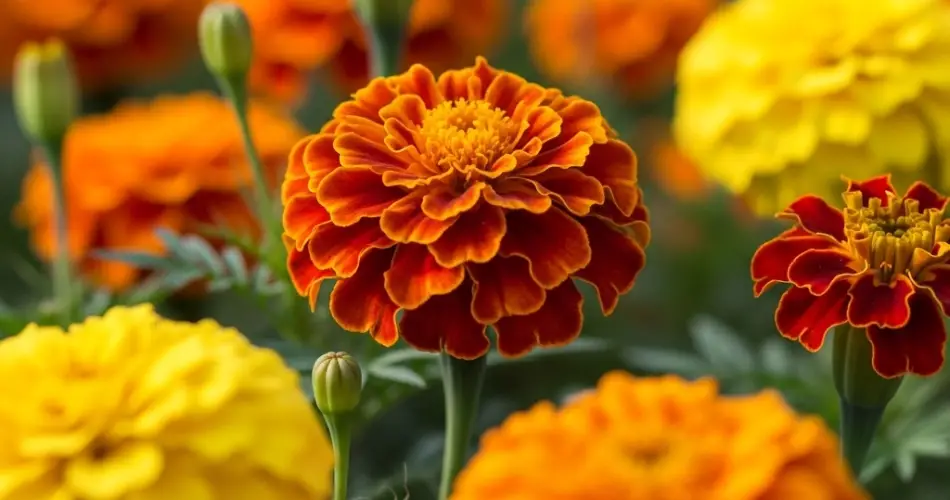Marigolds are some of the most cheerful and versatile flowers you can grow in the garden. With their bright hues of yellow, orange, red, and gold, they bring life to pots, beds, borders, and even vegetable patches. One of their biggest advantages is their adaptability—they thrive in containers as well as open garden spaces. Plus, marigolds are easy to grow, resilient, and helpful in repelling pests.
Choosing the right marigold variety for your space can make a significant difference. Some types are better suited for small pots or windowsill planters, while others spread out and flourish in wide garden beds. Here’s a detailed guide on the best marigold varieties for pots and garden beds, along with tips on how to grow them successfully.
1. French Marigolds (Tagetes patula)
Best for: Pots, window boxes, edging, and small garden beds
Height: 6–12 inches
Spread: 6–9 inches
French marigolds are compact, bushy, and flower continuously from late spring until frost. They come in a variety of colors, including deep orange, yellow, mahogany, and bi-color varieties. These marigolds are particularly well-suited for pots and small beds due to their manageable size.
Popular varieties:
-
Bonanza Mix: Full, double blooms in a range of warm colors.
-
Durango Series: Known for vibrant petals and strong stems.
-
Safari Series: Larger flowers for a bold container display.
French marigolds also have pest-repelling properties, making them excellent companions for vegetables like tomatoes and peppers.
2. African Marigolds (Tagetes erecta)
Best for: Garden beds, borders, and large containers
Height: 12–36 inches
Spread: 12–18 inches
African marigolds, sometimes called American marigolds, produce large, pom-pom-like flowers that are bold and showy. They are taller than French marigolds and make a dramatic impact in the landscape.
Popular varieties:
-
Crackerjack Mix: Tall plants with huge blooms in shades of yellow and orange.
-
Inca Series: Dense, double flowers with excellent heat tolerance.
-
Antigua Series: A more compact African marigold, suitable for large pots.
These marigolds prefer full sun and rich, well-draining soil. They are perfect for filling gaps in garden beds or creating vibrant, upright displays along fences or walls.
3. Signet Marigolds (Tagetes tenuifolia)
Best for: Edging, herb gardens, and containers
Height: 9–12 inches
Spread: 9–12 inches
Signet marigolds are different from other types due to their fine, fern-like foliage and delicate, single flowers. They also have a mild citrus scent and edible petals, which can be used to decorate salads and desserts.
Popular varieties:
-
Lemon Gem and Tangerine Gem: Compact and fragrant with masses of tiny blooms.
-
Paprika: Unique red blooms that add contrast to garden color schemes.
Signet marigolds do well in small pots, rock gardens, and alongside herbs like basil, thyme, and oregano. They thrive in leaner soil and don’t require heavy fertilization.
4. Triploid Marigolds (Hybrid Cross)
Best for: Garden beds and large containers
Height: 14–18 inches
Spread: 12–15 inches
Triploid marigolds are a cross between French and African marigolds. They combine the vigor of African marigolds with the compactness and weather resistance of French types. These hybrids are especially valuable in hot, humid climates, as they tolerate extreme conditions well.
Popular varieties:
-
Zenith Series: Continuous bloomer even in summer heat.
-
Nugget Series: Dense plants with rounded, uniform flowers.
Triploids are ideal for gardeners who want dependable, low-maintenance color all summer long.
Tips for Growing Marigolds in Pots and Garden Beds
1. Sunlight:
All marigold types prefer full sun—at least 6 hours of direct light daily. In shadier spots, flowering will reduce significantly.
2. Soil:
Use well-draining soil. In containers, a quality potting mix enriched with compost works best. Avoid heavy soils that retain water.
3. Watering:
Water at the base of the plant to prevent fungal issues. Allow the soil to dry slightly between watering. Overwatering can lead to root rot.
4. Deadheading:
Regularly remove spent blooms to encourage continuous flowering. Marigolds respond quickly to deadheading with fresh new buds.
5. Fertilization:
Marigolds don’t need much feeding. Too much nitrogen can result in lots of foliage but fewer flowers. A light application of organic compost or balanced fertilizer every 4–6 weeks is enough.
6. Pest Control:
Marigolds are generally pest-resistant and often used to deter aphids, whiteflies, and nematodes. They make great companion plants for vegetables and herbs.
Best Uses in the Garden
-
French marigolds line borders, walkways, or fill small patio pots.
-
African marigolds make excellent backdrop plants or vibrant focal points in garden beds.
-
Signet marigolds work well in herb spirals, cottage gardens, and even hanging baskets.
-
Triploids are ideal for tough summer conditions where other flowers may struggle.
Final Thoughts
Marigolds are bright, dependable flowers that belong in every gardener’s toolkit—whether you’re working with pots, raised beds, or a sprawling garden. With the right variety selection, you can enjoy a long season of color, pollinator activity, and natural pest control. Whether you prefer compact French types or tall African blooms, marigolds are a beautiful and beneficial addition to any growing space.



